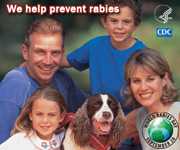Caring for client animals with potential exposure
For client animals WITH up-to-date rabies vaccinations
Dogs, Cats, and Ferrets
Dogs, cats, and ferrets that are currently vaccinated should be revaccinated immediately, kept under the owner’s control, and observed for 45 days. Any illness in an isolated or confined animal should be reported immediately to the local health department. If signs suggestive of rabies develop, the animal should be euthanized and the head shipped for testing.
Livestock
Livestock exposed to a rabid animal and currently vaccinated with a vaccine approved by USDA for that species should be revaccinated immediately and observed for 45 days.
If an exposed animal is to be slaughtered for consumption, it should be done immediately after exposure. Barrier precautions should be used by persons handling the animal, and all tissues should be cooked thoroughly. Historically, federal guidelines for meat inspectors have required that any animal known to have been exposed to rabies within 8 months be rejected for slaughter. USDA Food and Inspection Service (FSIS) meat inspectors should be notified if such exposures occur in food animals before slaughter.
Multiple rabid animals in a herd or herbivore-to-herbivore transmission is uncommon; therefore, restricting the rest of the herd if a single animal has been exposed to rabies is usually not necessary.
Other Animals
Other mammals exposed to a rabid animal should be euthanized immediately. Animals maintained in USDA-licensed research facilities or accredited zoological parks should be evaluated on a case-by-case basis.
For client animals WITHOUT up-to-date rabies vaccinations
Dogs, Cats, and Ferrets
Unvaccinated dogs, cats, and ferrets exposed to a rabid animal should be euthanized immediately. If the owner is unwilling to have this done, the animal should be placed in strict isolation for 6 months. Rabies vaccine should be administered to the animal upon entry into isolation or 1 month before release to comply with preexposure vaccination recommendations. No USDA biologics are licensed for postexposure prophylaxis of previously unvaccinated domestic animals, and evidence exists that the use of vaccine alone will not reliably prevent the disease in these animals. Animals with expired vaccinations need to be evaluated on a case-by-case basis.
Livestock
Unvaccinated livestock should be euthanized immediately. If the animal is not euthanized, it should be kept under close observation for 6 months. Any illness in an animal under observation should be reported immediately to the local health department. If signs suggestive of rabies develop, the animal should be euthanized and the head shipped for testing. Multiple rabid animals in a herd or herbivore-to-herbivore transmission is uncommon; therefore, restricting the rest of the herd if a single animal has been exposed to or infected by rabies is usually not necessary.
Other Animals
Other mammals exposed to a rabid animal should be euthanized immediately. Animals maintained in USDA-licensed research facilities or accredited zoological parks should be evaluated on a case-by-case basis.
- Page last reviewed: April 22, 2011
- Page last updated: April 22, 2011
- Content source:





 ShareCompartir
ShareCompartir